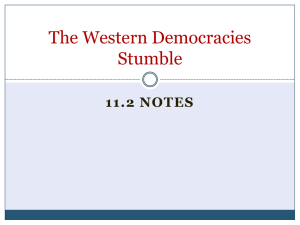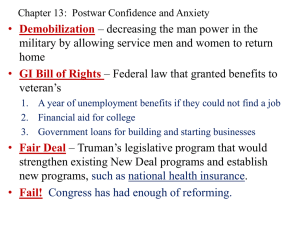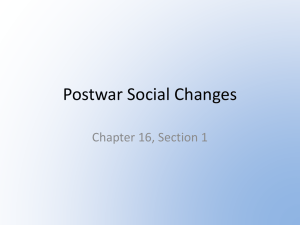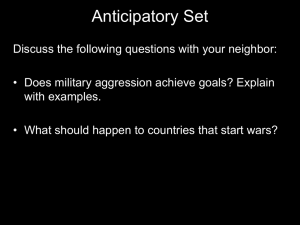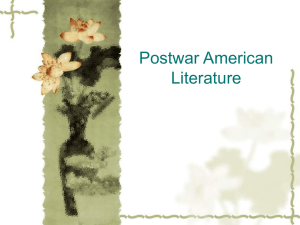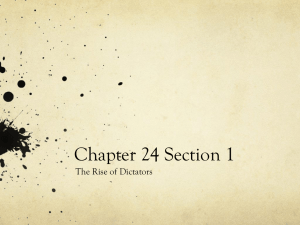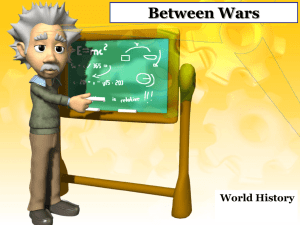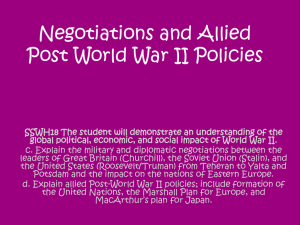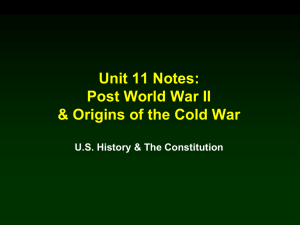Chapter 19 – Entire Chapter Presentation
advertisement
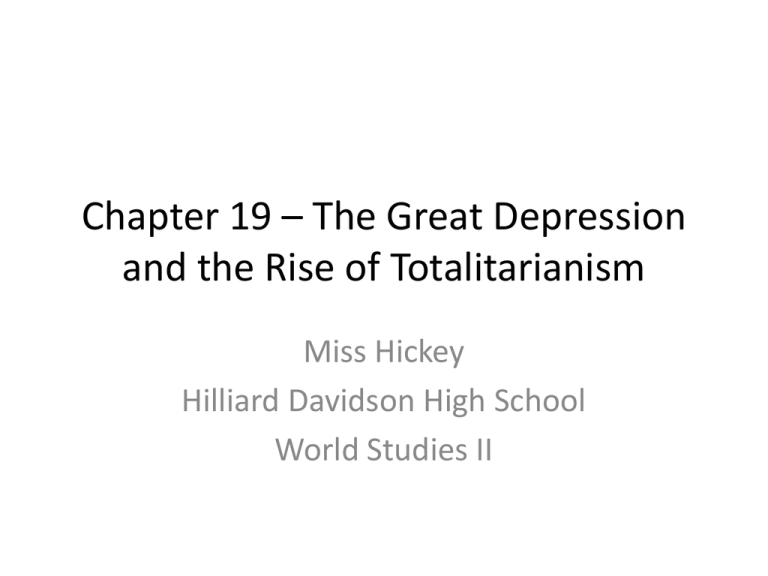
Chapter 19 – The Great Depression and the Rise of Totalitarianism Miss Hickey Hilliard Davidson High School World Studies II The Postwar War Chapter 19 – Section 1 • The Main Idea: The work of artists, musicians, and writers in the postwar ear reflected global anxieties. • The Tangent Idea: The postwar ear provided super-sweet slang. – – – – “the cat’s meow” = something wonderful “glad rags” = fancy clothing “in a pig’s eye” = something that will never happen “doll,” “dame,” “babe,” “broad,” “dish” and “skirt” The Postwar War Chapter 19 – Section 1 • Explain how scientific theories affected thinking in other areas of life. • Identify ways in which writers, musician, painters and architects experimented with new forms. • Describe how popular culture and consumerism affected societies. The Effects of Scientific Events and Ideas • Influenza pandemic – killed many in 2-3 days – killed 20 million (more people than WWI) – Showed how little doctors understood about disease • Explanations for Frightening World – Sigmund Freud (unconscious trumped rational mind) – Albert Einstein (everything is relative) Influenza Pandemic Lost Generation of Writers • showed dissatisfaction with traditional ideas • offered a new vision • Lost Generation of Writers – Ernest Hemingway • The Sun Also Rises – F. Scott Fitzgerald • The Great Gatsby – John Dos Passos Lost Generation Experimenting with Form • Marcel Proust (French writer) – Remembrance of Things Past (1913; after WWI) • Thomas Mann (German) – The Magic Mountain (1924) • Franz Kafka (Czech writer) used surrealism (brings conscious and unconscious ideas together to portray life in a dreamlike way) – The Castle (1926) – The Metamorphosis • James Joyce (Irish writer) used stream on consciousness (attempts to record everything that comes into a character's mind) – Ulysses (1922) • T.S. Eliot (American poet) – The Waste Land (1922) stream on consciousness (attempts to record everything that comes into a character's mind) surrealism (brings conscious and unconscious ideas together to portray life in a dreamlike way) Postwar Music • Igor Stravinsky (Russian composer) – see class Web site – The Rite of Spring (1913) - ballet • Arnold Schoenberg (Austrian composer) – Quartet for Violin, Clarinet, Tenor Saxophone, and Piano. • Radio – helped give rise to the popularity of new music such as jazz, which originated in New Orleans and fused styles from West Africa and Latin America with sounds from African American folk music and some European styles. • Louis Armstrong • Billie Holiday • “Jelly Roll” Morton Postwar Painting • Cubism – influenced by traditional African art, emphasized geometric designs, using shapes such as cubes, flat planes, and spheres – showed objects from several different viewpoints at the same time. • Pablo Picasso • Georges Braque • Surrealism – represented the unconscious – featured objects that did not relate • Dadaists – Used random images to reflect what they considered the insanity of war • Wassily Kandinsky (Russian) • Piet Mondrian (Dutch) • Traditional Chinese art – Ch’i Pai-shih Pablo Picasso and Cubism Postwar Architecture • Functionalism – building designed for specific used instead of to a specific style – structural steel • Louis Sullivan (American) • Frank Lloyd Wright (American, student of Sullivan) Frank Lloyd Wright Postwar Consumerism • Credit – People became focused on the present and less focused on the future • Automobile – No longer a luxury good – Changed society • Radio – Advertising • Flappers (ladies) – Reaction: 18th Amendment – Prohibition • Made alcohol illegal in 1920; overturned in 1933 Chapter 19 – Section 2 Questions • How did Freud’s notion of the irrational and the subconscious influence postwar literature? • How did technology lead to advances in architecture? Postwar Prosperity Crumbles Chapter 19 – Section 2 • Identify the weaknesses that appeared in the global economy during the postwar era. • Describe how nations initially responded to the Great Depression. • Explain how the New Deal marked a shift in the U.S. government’s relationship with its citizens and the economy. Signs of Economic Troubles • Farmers - overextended • Protectionism – economic nationalism • Speculation and panic – Market speculation – Black Tuesday, October 29, 1929 • bankruptcy – different types The Great Depression • Reading and understanding statistics – 30 million people unemployed throught the industrialized world • Violence and unrest • Table on p. 544 of the textbook The New Deal • Herbert Hoover – “just around the corner” – Hoovervilles • 1932 – Franklin D. Roosevelt – New Deal • Social Security Act (1935) • 40 hour work week • alphabet soup Chapter 19 – Section 2 Questions • What was the effect of the U.S. stock market crash in 1929? • What New Deal programs led to reforms in the American economy? Political Tensions After WWI Chapter 19 – Section 3 • Describe the difficulties that France faced during the postwar years. • Explain how the British government dealt with its domestic problems. • Identify the problems that weakened eastern European governments. France’s Postwar Difficulties • The economy – debts – Maginot Line (200 mile-long defense) • Germany had invaded France 2x in 50 years • International affairs • Political unrest – Left • General strike • Popular Front – Leon Blum (1936) – Right • riots (1934) • Wanted dictatorship (end republic) Great Britain After WWI • Labor troubles – Ramsay MacDonald • helped maintain democracy • set tight government budgets • helped construction industry • Ireland – Easter Rising – Sinn Fein (Irish Nationalist Part) • Michael Collins • Irish Republican Army (IRA) • Split in Two (1922) – Northern Ireland (Protestant) – Republic of Ireland (Catholic) Eastern Europe • Geography • Austria – Wanted to join Germany (forbidden) – Vienna vs. Country People – Rise of authoritarian government and decline of democracy • Hungary = a giant hot mess – 1918 republic – 1919 Bela Kan – Miklos Horthy (admiral – military class) Chapter 19 – Section 3 Questions • What economic and political problems did France face after World War I? • What economic and political problems did eastern European nations face after World War I? Fascist Dictatorships in Italy and Germany Chapter 19 – Section 4 • Describe how Benito Mussolini transformed Italy into a fascist state. • Explain why the Weimar Republic failed. • Trace how Adolf Hitler became an important figure in Germany. • Describe how the Nazis used power in Germany. The Rise of Fascism in Italy • Benito Mussolini – Rise to power (anti-communism; protection of private property) – suspended: • Freedom of speech • Freedom of the press • Trial by jury • Fascism – Fascist doctrine • Corporatist State – Area of economic activity • Communism & Fascism (means of control: force & censorship) The Weimar Republic • Kaiser abdicated • The Weimar Republic – – – – – Weak Signed the Treaty of Versailles Crazy-high inflation Both communists and fascists wanted to overthrow Bier Hall Putsch • Adolf Hitler • Nazis The Nazis and Hitler • Adolf Hitler – Promised to restore the power and glory of Germany – Emergency powers (Fire of Reichstag) • Dictator in 1933 (like Octavian/Augustus) • Der Fuhrer (the leader) • Gestapo (secret police) – persecuted “inferior races” – Ghettos, Star of David • Nazi Party (Nationalist Socialist German Workers Party) – Anti-Semitic – Anticommunist – Nationalistic (extremely) • Third Reich (Third Empire) – 1st: Holy Roman Empire – 2nd: Hohenzollerns Chapter 19 – Section 4 Questions • What role did communism play in Mussolini’s rise to power? • How did Hitler turn Germany into a police state after 1933? Dictatorship in the Soviet Union Chapter 19 – Section 5 • Identify the terms of the New Economic Policy. • Describe how Stalin shaped the Soviet economy. • Explain why Stalin imprisoned and executed millions of Soviet people. Russia Under Lenin • 1922 Russia Union of Soviet Socialist Republics (USSR) • New Economic Policy (NEP) – Nepmen (businessmen) • Women’s Roles – 1917 – – – – equal to men equal pay for equal work easier to obtain a divorce maternity leave • Education – focused on higher education (at expense of elementary) • Most people had fewer than 3 years of education – poorly funded – promoted communist doctrine 5-Year Plan • Vladimir Lenin – died in 1924 • Leon Trotsky – Exiled in 1928 – Murdered in 1940 (in Mexico) • Joseph Stalin – came to power in 1928 • Command economy • Impact on soviet life Lenin Trotsky Stalin Stalin’s Dictatorship • Government • Foreign policy Chapter 19 – Section 5 Questions • What was the goal of the first Five-Year Plan? • How did Stalin insure loyalty from government and the party officials and from the Soviet people? Chapter 19 – Reviewing Themes • Why did western European nations and the United States fail to respond to Germany’s violations of the Treaty of Versailles? • How did Hitler use Germany’s democratic system to gain control over the country? • How did the work of Feud and Einstein influence culture during the 1920s? Chapter 19 – Thinking Critically • Why were the Allied nations in western Europe more successful at remaining democratic after World War I? • Why did nations practice economic nationalism if this policy only prolonged the depression? • Why might there be a relationship between communist or fascist doctrines and the development of the police state? • What was life like for the average Soviet citizen during the 1930s? Chapter 19 Review • • • • • • • • • • Igor Stravinsky cubism economic nationalism Franklin D. Roosevelt general Strike popular front fascism third Reich collective farms command economy


